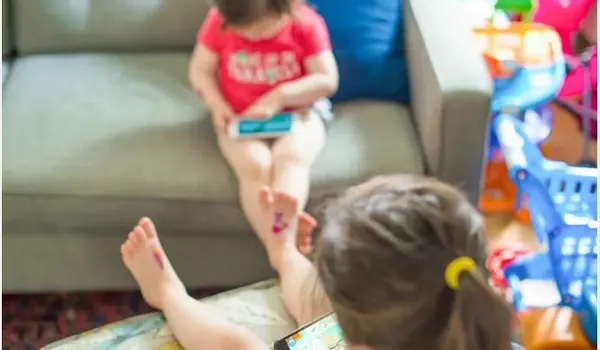There is some evidence to suggest that relying too heavily on digital devices to soothe young children may have negative consequences. One concern is that the overuse of screens can disrupt sleep patterns, particularly if the child is exposed to screens close to bedtime. The blue light emitted by screens can interfere with the body’s production of melatonin, a hormone that helps regulate sleep, making it harder for children to fall asleep and stay asleep.
The use of devices such as smartphones and tablets to calm upset children aged 3-5 was linked to increased emotional dysregulation in children, particularly boys. Many parents have witnessed this scenario: their child has a meltdown while they are attempting to cook dinner, make a phone call, or run an errand. And, on occasion, handing a fussy preschooler a digital device appears to provide a quick fix. However, new research suggests that this calming strategy may be linked to future behavioral issues.
According to a Michigan Medicine study published in JAMA Pediatrics, frequent use of devices such as smartphones and tablets to calm upset children aged 3-5 was associated with increased emotional dysregulation in children, particularly in boys.
“Using mobile devices to settle down a young child may seem like a harmless, temporary tool to reduce stress in the household, but there may be long-term consequences if it’s a regular go-to soothing strategy,” said lead author Jenny Radesky, M.D., a developmental-behavioral pediatrician at the University of Michigan Health C.S. Mott Children’s Hospital.
“Particularly in early childhood, devices may displace opportunities for the development of independent and alternative methods to self-regulate.”
Our findings suggest that using devices to appease agitated children may especially be problematic to those who already struggle with emotional coping skills. Caregivers may experience immediate relief from using devices if they reduce children’s negative and challenging behaviors quickly and effectively.
Jenny Radesky
The study included 422 parents and 422 children ages 3-5 who participated between August 2018 and January 2020, before the COVID-19 pandemic started. Over a six-month period, researchers examined parent and caregiver responses to how frequently they used devices as a calming tool, as well as associations to symptoms of emotional reactivity or dysregulation.
Signs of increased dysregulation could include rapid shifts between sadness and excitement, a sudden change in mood or feelings, and heightened impulsivity. According to the findings, the relationship between device-calming and emotional consequences was especially strong among young boys and children who may already have hyperactivity, impulsiveness, and strong temperament, making them more likely to react intensely to feelings like anger, frustration, and sadness.
“Our findings suggest that using devices as a way to appease agitated children may especially be problematic to those who already struggle with emotional coping skills,” Radesky said. She notes that the preschool-to-kindergarten period is a developmental stage when children may be more likely to exhibit difficult behaviors, such as tantrums, defiance, and intense emotions. This may make it even more tempting to use devices as a parenting strategy.
“Caregivers may experience immediate relief from using devices if they reduce children’s negative and challenging behaviors quickly and effectively,” Radesky says. “Both parents and children will find this rewarding, and it may motivate them both to continue in this cycle.”
“As children’s media demands increase, so does the habit of using devices to manage difficult behavior.” The more frequently devices are used, the less opportunity children and their parents – have to practice other coping strategies.”

Alternative soothing methods can help build emotion regulation skills
Radesky, who is a mother of two herself, acknowledges that there are times when parents may strategically use devices to distract children such as during travel or multitasking with work. While occasional use of media to occupy children is expected and realistic, it is important for it not to become a primary or regular soothing tool.
Pediatric health professionals should also initiate conversations with parents and caregivers about using devices with young children and encourage alternative methods for emotional regulation, she says.
Among solutions Radesky recommends when parents are tempted to turn to a device.
- Sensory techniques: Each child has a different profile of what types of sensory input calm them down. Swinging, hugging, or pressure, jumping on a trampoline, squishing putty in their hands, listening to music, or looking at a book or sparkle jar are all examples. If you notice your child becoming agitated, redirect that energy to body movement or sensory approaches.
- Label the emotion and what to do about it: When parents label what they believe their child is feeling, they not only help the child connect language to emotional states, but they also demonstrate to the child that they are understood. The more calm parents are, the more they can show their children that emotions are “mentionable and manageable,” as Mister Rogers used to say.
- Use color zones: When children are young, they have a hard time thinking about abstract and complicated concepts like emotions. Color zones (blue for bored, green for calm, yellow for anxious/agitated, red for explosive) are easier for kids to understand and can be made into a visual guide kept on the fridge, and help young children paint a mental picture of how their brain and body is feeling. Parents can use these color zones in challenging moments (“you are getting wiggly and in the yellow zone – what can you do to get back to green?”)
- Provide substitute behaviors: When kids are upset, they can exhibit some pretty negative behaviors, and it’s natural to want them to stop. However, because those behaviors communicate emotions, children may need to be taught a safer or more problem-solving replacement behavior to do instead. Teaching a sensory strategy (“hitting hurts people; hit this pillow instead”) or clearer communication (“if you want my attention, tap my arm and say ‘excuse me, mom.'”
Parents can also prevent tech-related tantrums by using timers, setting clear expectations for when and where devices can be used, and using apps or video services that have clear stopping points rather than just auto-playing or allowing the child to keep scrolling.
When children are calm, caregivers can teach them emotional coping skills, according to Radesky. They can, for example, talk to them about how their favorite stuffed animal is feeling and how they handle big emotions and calm down. This type of playful discussion employs and appeals to children’s language.
“All of these solutions help children understand themselves better and feel more competent in dealing with their emotions,” Radesky said. “It takes repetition on the part of the caregiver, who must also try to remain calm and not overreact to the child’s emotions, but it helps build emotion regulation skills that last a lifetime.”















